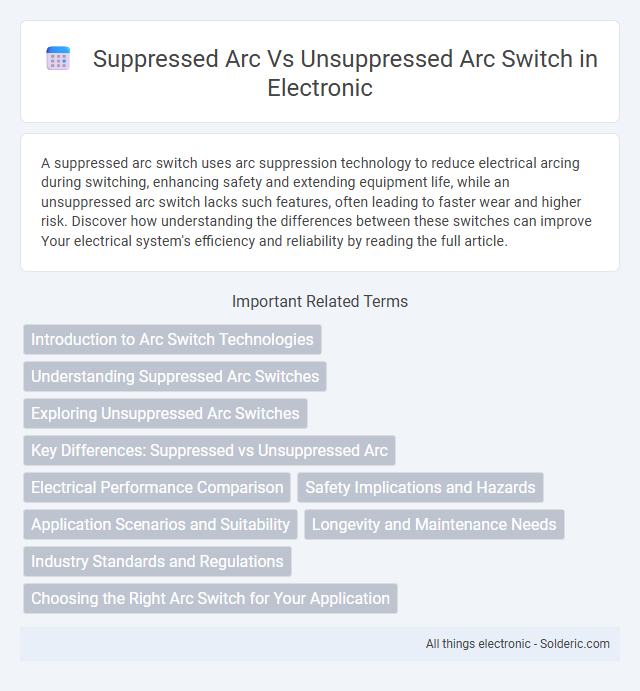A suppressed arc switch uses arc suppression technology to reduce electrical arcing during switching, enhancing safety and extending equipment life, while an unsuppressed arc switch lacks such features, often leading to faster wear and higher risk. Discover how understanding the differences between these switches can improve Your electrical system's efficiency and reliability by reading the full article.
Comparison Table
| Feature | Suppressed Arc Switch | Unsuppressed Arc Switch |
|---|---|---|
| Arc Suppression | Yes, actively reduces arc duration and intensity | No, allows arc to form and extinguish naturally |
| Contact Wear | Reduced wear due to shorter arc time | Higher wear from prolonged arcing |
| Switch Longevity | Longer lifespan due to arc control | Shorter lifespan due to damage from arcs |
| Application | Used in sensitive or high-voltage switching | Common in low-voltage or simple load circuits |
| Safety | Higher safety with reduced risk of fire and damage | Lower safety due to uncontrolled arc |
| Cost | Generally higher due to added components | Lower cost with simpler design |
Introduction to Arc Switch Technologies
Arc switch technologies manage electrical arcs formed during circuit interruption to enhance safety and equipment longevity. Suppressed arc switches use extinguishing mediums like vacuum or SF6 gas to rapidly quench arcs, reducing contact erosion and maintenance needs. Unsuppressed arc switches rely on natural air or minimal intervention, making them simpler but less effective in controlling arc energy, which may impact operational reliability in high-load applications.
Understanding Suppressed Arc Switches
Suppressed arc switches utilize arc suppression techniques such as arc chutes, magnetic blowouts, or vacuum interrupters to minimize electrical arcing during the switching process, enhancing safety and extending switch lifespan. These switches reduce the risk of contact erosion and electrical faults by controlling and quickly extinguishing the arc, which is critical in high-voltage and industrial applications. In contrast, unsuppressed arc switches allow arcs to persist longer, leading to faster wear and higher maintenance requirements.
Exploring Unsuppressed Arc Switches
Unsuppressed arc switches allow electrical arcs to persist during contact separation, offering faster operation and reduced component wear in low-voltage applications. These switches rely on the natural extinction of the arc without integrated arc suppression mechanisms, making them suitable for circuits with lower switching capacity. Their design prioritizes simplicity and cost-efficiency while maintaining reliability in environments where arc energy is manageable without additional suppression.
Key Differences: Suppressed vs Unsuppressed Arc
A suppressed arc switch uses arc suppression technology to quickly extinguish the electrical arc formed during contact separation, thereby reducing contact wear and increasing switch lifespan. An unsuppressed arc switch lacks this feature, causing prolonged arcing that can lead to faster deterioration and potential safety hazards. The key difference lies in arc control efficiency, where suppressed arc switches improve reliability and safety in high-current applications.
Electrical Performance Comparison
Suppressed arc switches significantly reduce electrical noise and transient voltage spikes compared to unsuppressed arc switches, enhancing circuit stability and protecting sensitive components. Unsuppressed arc switches generate higher electromagnetic interference (EMI) and exhibit slower arc quenching, leading to increased contact wear and reduced lifespan. The superior arc interruption capability in suppressed arc switches results in improved reliability and overall electrical performance in high-current applications.
Safety Implications and Hazards
Suppressed arc switches reduce the risk of electrical fires and operator injury by quickly quenching the arc generated during contact separation, minimizing exposure to extreme heat and molten metal. Unsuppressed arc switches allow arcs to persist longer, increasing the likelihood of burns, equipment damage, and hazardous gas emissions, posing significant safety threats. Choosing a suppressed arc switch enhances Your protection against electrical hazards in high-current applications.
Application Scenarios and Suitability
Suppressed arc switches are ideal for high-voltage industrial applications where minimizing electromagnetic interference (EMI) and extending switch lifespan are critical, such as in sensitive electronic equipment and power distribution systems. Unsuppressed arc switches suit low-voltage, low-frequency environments like household appliances or basic lighting circuits, where cost efficiency and simplicity outweigh concerns about arc generation. Your choice depends on balancing operational demands: opt for suppressed arc switches in precision or heavy-duty settings, while unsuppressed variants are practical for general, less demanding applications.
Longevity and Maintenance Needs
Suppressed arc switches significantly extend longevity by minimizing contact erosion through arc quenching technologies, reducing wear and tear on components. Unsuppressed arc switches experience faster degradation due to intense electrical arcs, demanding more frequent maintenance and contact replacements. The lower maintenance needs and longer service life of suppressed arc switches result in higher reliability and reduced operational costs.
Industry Standards and Regulations
Suppressed arc switches comply with stringent industry standards such as IEEE C37.20 and IEC 62271, ensuring enhanced safety and reduced electromagnetic interference during operation. Unsuppressed arc switches may meet basic electrical safety standards but often lack advanced arc interruption features required in critical industrial applications. Regulatory bodies emphasize suppressed arc technology in sectors like power distribution and manufacturing to minimize fire hazards and equipment damage.
Choosing the Right Arc Switch for Your Application
Selecting the right arc switch depends on your application's voltage and current requirements, with suppressed arc switches offering enhanced safety by reducing arc energy and increasing switch lifespan. Unsuppressed arc switches may be suitable for low-voltage, low-frequency uses where arc suppression is less critical, providing a cost-effective solution. Assessing factors such as load type, switching frequency, and maintenance needs ensures optimal performance and durability in your electrical system.
suppressed arc vs unsuppressed arc switch Infographic

 solderic.com
solderic.com